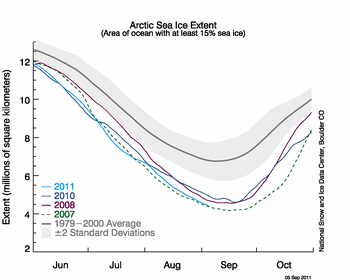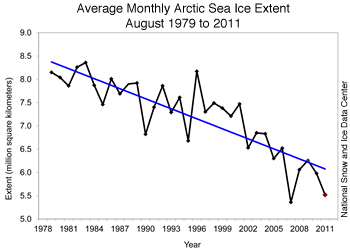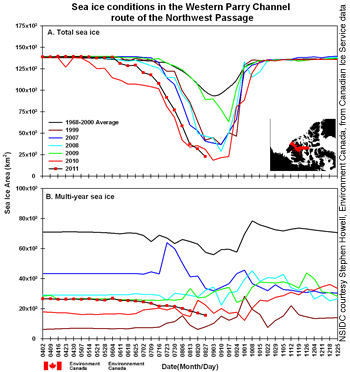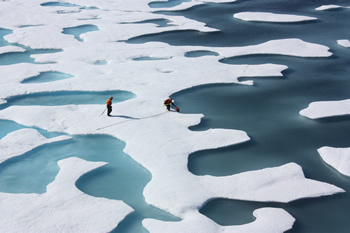Overview of conditions
Average ice extent for August 2011 was 5.52 million square kilometers (2.13 million square miles). This is 160,000 square kilometers (61,800 square miles) above the previous record low for the month, set in August 2007, and 2.15 million square kilometers (830,000 square miles), or 28% below the average for 1979 to 2000. Sea ice coverage remained below normal everywhere except the East Greenland Sea. In addition, several large areas of open water (polynyas) have opened within the ice pack.
Average ice extent for August 2011 was 5.52 million square kilometers (2.13 million square miles). This is 160,000 square kilometers (61,800 square miles) above the previous record low for the month, set in August 2007, and 2.15 million square kilometers (830,000 square miles), or 28% below the average for 1979 to 2000. Sea ice coverage remained below normal everywhere except the East Greenland Sea. In addition, several large areas of open water (polynyas) have opened within the ice pack.
On August 31, 2011 Arctic sea ice extent was 4.63
million square kilometers (1.79 million square miles). This is 100,000
square kilometers (38,600 square miles) higher than the previous record
low for the same day of the year, set in 2007. As of September 5, ice
extent had fallen below the minimum ice extents in September 2010 and
2008 (previously the third- and second-lowest minima in the satellite
record). If ice stopped declining in extent today it would be the
second-lowest minimum extent in the satellite record.
 |
|
Figure 2. The graph above shows daily Arctic sea ice extent as of
September 2, 2011, along with daily ice extents for previous
low-ice-extent years. Light blue indicates 2011, dashed green shows
2007, dark blue shows 2010, purple shows 2008, and dark gray shows the
1979 to 2000 average. The gray area around the average line shows the
two standard deviation range of the data. Sea Ice Index data. —Credit: National Snow and Ice Data Center |
In August, sunlight wanes in the Arctic and the sea ice decline starts to slow down. Although the decline slowed somewhat during August, ice extent retreated at a faster pace than average, at a pace of 67,700 square kilometers (26,100 square miles) per day. In comparison, the average rate of decline for August 1979 to 2000 was 53,700 square kilometers (20,700 square miles) per day.
Air temperatures were 1 to 4 degrees Celsius (2 to 7 degrees Fahrenheit) higher than average (relative to the 1981 to 2010 climatology) over the Arctic Ocean (measured approximately 1000 meters above the surface). The strongest anomalies were over the Northwest Passage region. High pressure persisted over much of the central Arctic Ocean, associated with a wind pattern that helped to push ice from the Beaufort Sea westward into the Chukchi Sea. This may have slowed some ice loss in the Chukchi Sea region. However, the wind pattern also transported ice into open waters warmed during the summer, fostering melt.
 |
Average Arctic sea ice extent for August 2011 was the second-lowest for August in the satellite data record. Including 2011 the linear trend for August now stands at –9.3% per decade.
Northwest Passage sea ice at record low levels
Sea ice is now almost completely gone from the
channels of the Northwest Passage, with the exception of a small strip
of ice across a stretch of the Parry Channel. The southern route
(Amunden's Route) is ice free. According to the Canadian Ice Service,
sea ice extent in the western Parry Channel is now the lowest at this
time of year since record keeping began in 1966 and very little
multi-year ice remains. According to Multisensor Analyzed Sea Ice Extent (MASIE) data, ice cover across the Canadian Archipelago is at record low levels.
The Northern Sea Route along Siberia remains
ice-free, with a number of cargo ships passing through in recent weeks.
However, some areas of older, thicker ice have helped preserve the
tongue of ice extending into the East Siberian Sea.


Sem comentários:
Enviar um comentário